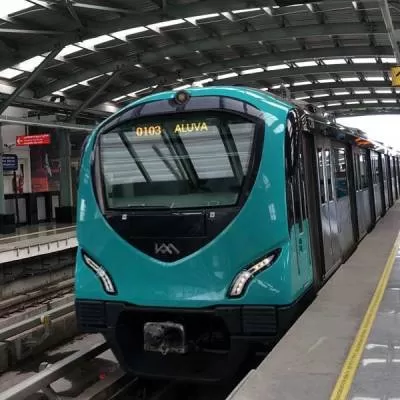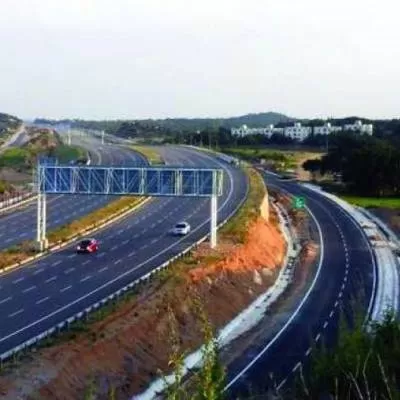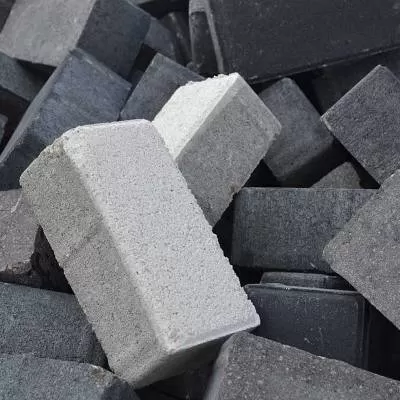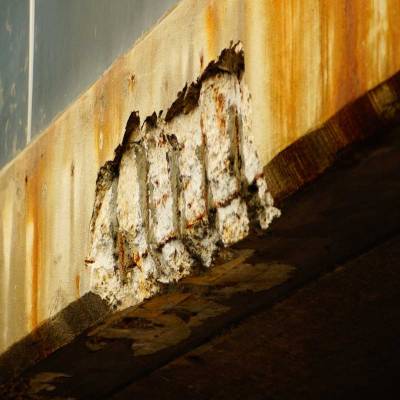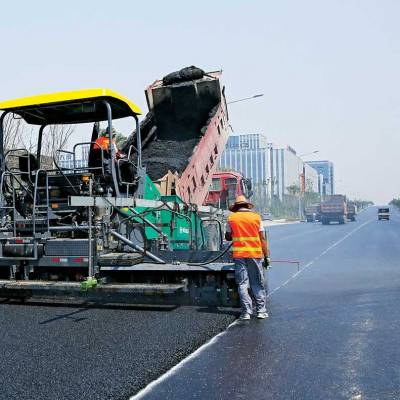- Home
- Building Material
- Concrete
- Something Concrete
Something Concrete
The first apprehension was whether the soil-like dry material was concrete. Questions on how it could be laid, quality control and control over construction processes were paramount when the material was first used. "I was surprised when I saw this concrete for the first time in 2002; having worked in Mumbai where mixtures are cement-rich, I was unacquainted to seeing such lean mixtures with such low cement content," says Dr Chetan Hazaree, Deputy General Manager - Research and Development, Hindustan Construction Company Ltd (HCC). "Any RMC plant producing conventional concrete will use relatively higher amounts of cement, unlike a typical roller compacted concrete (RCC) for pavement applications." Highlighting its applications and practical considerations, Hazaree tells Shriyal Sethumadhavan why RCC as a construction material is making waves in India, apart from the US, Brazil and Canada.
Humble beginnings
As the name suggests, RCC is compacted using vibratory rollers instead of conventional compaction operations. Generally applied in two areas of engineered construction - hydraulic and pavement structures - in the past 25 years, it has been recognised as one of the most important developments in concrete dam technology and is a relatively younger and evolving technology for pavements. In 1930, RCC was first applied in its preliminary form in Sweden, in 1942 in the USA, and the first RCC pavement was built in Canada in 1976. In India, RCC for pavement applications is known as dry lean concrete (DLC), which was used in the Mumbai-Pune Expressway, one of the first concrete roads developed on a mega scale. Further, it has been used in the National Highway Authority of India's (NHAI) Golden Quadrilateral Project. The use of RCC for rigid pavement or concrete pavement began here.
Material matters
Also recognised as no-slump concrete or econocrete, RCC initially handles like a soil and later results in true concrete or concrete-like material, making it a unique combination of soil-concrete. It is a very stiff mixture of cement, aggregate, water and chemical admixtures capable of taking the weight of a compacting roller when fresh. When applied with a combination of plain and vibratory compaction, roller compaction densifies RCC to the maximum density possible at the optimum moisture content, leaving behind nominal entrapped air content (up to 2 per cent with a maximum aggregate size of 25 mm). The degree of compaction or density decides the strength and the durability that RCC can achieve; hence compaction is a critical operation in making better performing concrete. In India, this material has been partially approved by the government. While constructing rigid pavements, usually 4-6 inches of dry lean concrete (DLC) is provided.
Materials within a material
RCC can be manufactured with an array of concrete-making materials and its performance primarily depends on the quality and gradation of aggregates, degree of compaction and proportions of cement, pozzolan and water. With reference to binders, Ordinary Portland Cement (OPC), blended cements, fly ash, slag and silica fume can be used depending on availability of materials, construction specifications and structural requirements of concrete. Finer materials in the form of supplementary cementitious materials help improve the compactability and finishability of the mixtures.
Different aggregates varying from virgin aggregate, recycled concrete (including bitumen concrete) aggregate and marginal aggregate can be used while being cognisant of compactability, reduced segregation and finishability. Some increased quantity of fines from sand may be required for improved compaction and finishability and to enhance segregation resistance.
Chemical admixtures have not been widely used in RCC. However, the trend for using plasticisers and retarders to enhance the cohesiveness and extend the compaction time window is growing. In cold regions, air entraining admixtures are used to extend the serviceable life of RCC pavements, while offering protection against alternating freezing and thawing. In fact, it might take another three to five years for the admixture technology to evolve enough to offer proper solutions, as RCC is not fully understood yet.
Practical applications
RCC requires vigorous mixing to ensure proper dispersion of cement, admixtures and to reduce segregation and other losses. Once mixed in a central mixing plant, it is then transported in dumpers to the paving site within an acceptable time span (usually 45-60 minutes). Adequate compensation is made for moisture losses, and thus loss of workability, before the concrete starts getting compact.
RCC is paved on well-prepared, clean and lightly moistened sub-grade. When used in concrete pavements as a base layer, a de-bonding (plastic) sheet or thin asphalt coat may also be used. It is usually placed using asphalt pavers or regular concrete pavers (without needle vibrators) to the required thickness.
Moisture content is monitored during compaction, as it governs the potential density that the compacted material can reach. Drier concrete (moisture content below optimum moisture content) will tend to consume more fuel as it would demand a greater number of passes and often might not achieve the specified degree of compaction. However, mixtures on the wet side would lead to time losses as the roller will not be able to operate without forming a wavy surface or causing edge slump. Hence, keeping moisture content close to optimum moisture content ± 0.5 per cent is advisable.
Saw cutting is usually started within the first 16-24 hours. This may not be required when RCC is used either as a pavement base or overlaid with asphalt or concrete. Saw cuts must be added at regular intervals to prevent unplanned s and associated damage during the lifetime of the pavement. Water curing, usually done for the first seven days, can be achieved using water tankers filled with sprayers or sprinklers, spreading plastic sheets after spreading water or with curing compounds.
Experiences with application
Studies have been conducted on the fresh properties of concrete to understand its workability, friction angle, cohesion in the mixes, segregation resistance and so on. RCC behaves distinctly differently when compared to routine concrete. Moreover, it surpasses performances in terms of compressive, flexural and tensile strengths at a similar cement content and when compared to conventional concrete. However, the fatigue behaviour of this concrete needs to be understood in detail for improved pavement analysis and design.
A sampling of the possible RCC applications in pavement structures include pavement bases with lower cement content, low maintenance roads and parking areas, industrial access roads surfaced with or without asphalt or concrete overlay, inlay rehabilitation, fast track intersections, shoulder construction and reconstruction, city streets and airport aprons and taxiways. At HCC, we have been constructing roads with the use of RCC in many projects. I have personally used this material while working on the NH-4 - Satara-Kolhapur highway and in constructing city roads in Surat.
Concrete challenges
There were several occasions when we had to train and calibrate ourselves to use RCC. For instance, typical concrete is put in a cube mould and filled in three to four layers with the help of a simple rod. But RCC requires preparation with a special compacting hammer. Also, during production, we were apprehensive about whether our ready-mix concrete plant could consistently deliver this kind of concrete. Hence, instead of producing a 3 cu m batch, we restricted ourselves to 2- 2 œ cu m at a time.
As compaction of RCC and the resulting performance is sensitive to moisture content, it affects the final quality; hence, during transportation, we need to cover the dumpers. Quality control is a combination of methods used on soils and concrete. During execution, the field density and compressive strength are checked.
Pros and cons
When the United States Army Corps of Engineers (USACE) compared the cost of RCC and conventional Portland cement concrete (PCC) pavements in 1995, they analysed 49 different USACE projects where RCC had been used for different applications. Savings ranged from 14 to 58 per cent compared to conventional concrete pavements. Similar figures apply to India as well with slight differences in equipment and labour costs. However, detailed studies are required to substantiate this argument.
Amongst its benefits, RCC does not require any formwork, dowel joints, steel, finishing, or joint cutting (if done, it is at a much longer spacing), and it has higher production rates and shorter traffic opening times. Its drawback lies in relatively poor finishability and less comfortable riding quality. Additionally, there is not much research that has been conducted or published performance data about its other properties - nevertheless, studies are going on.
People-planet-profit
With India undergoing large-scale infrastructure construction, RCC offers itself as an alternative, durable and sustainable pavement option. The definition of sustainability talks about three things: people, planet and profit. For the planet, alternative materials like recycled aggregates can be used; equipment cost is reduced, material has longer life, comparatively requires less maintenance hence resulting in lesser lifecycle cost. But in India, we tend to think of the initial cost and ignore the life cycle cost. If the government saves Rs 5 in road construction, ultimately the taxpayer saves too, and in the long term, even Re 1 or Rs 10 saved per unit can lead to increased savings. Hence, the use of RCC not only serves the people and the planet but leads to profits.
There is a pressing need for awareness and education about RCC and its uses. In India, we tend to merely imitate and follow routine paths and do not try to be innovative. However, one needs to think beyond this and push the concept ahead.
To share your experience with any construction material, write in at feedback@ASAPPmedia.com
In the sixth in a series of features showcasing experiences with building materials, Dr Chetan Hazaree, Manager - Research and Development, HCC, talks about roller compacted concrete (RCC) as a sustainable alternative to pavement concrete.The first apprehension was whether the soil-like dry material was concrete. Questions on how it could be laid, quality control and control over construction processes were paramount when the material was first used. I was surprised when I saw this concrete for the first time in 2002; having worked in Mumbai where mixtures are cement-rich, I was unacquainted to seeing such lean mixtures with such low cement content, says Dr Chetan Hazaree, Deputy General Manager - Research and Development, Hindustan Construction Company Ltd (HCC). Any RMC plant producing conventional concrete will use relatively higher amounts of cement, unlike a typical roller compacted concrete (RCC) for pavement applications. Highlighting its applications and practical considerations, Hazaree tells Shriyal Sethumadhavan why RCC as a construction material is making waves in India, apart from the US, Brazil and Canada.Humble beginningsAs the name suggests, RCC is compacted using vibratory rollers instead of conventional compaction operations. Generally applied in two areas of engineered construction - hydraulic and pavement structures - in the past 25 years, it has been recognised as one of the most important developments in concrete dam technology and is a relatively younger and evolving technology for pavements. In 1930, RCC was first applied in its preliminary form in Sweden, in 1942 in the USA, and the first RCC pavement was built in Canada in 1976. In India, RCC for pavement applications is known as dry lean concrete (DLC), which was used in the Mumbai-Pune Expressway, one of the first concrete roads developed on a mega scale. Further, it has been used in the National Highway Authority of India's (NHAI) Golden Quadrilateral Project. The use of RCC for rigid pavement or concrete pavement began here.Material mattersAlso recognised as no-slump concrete or econocrete, RCC initially handles like a soil and later results in true concrete or concrete-like material, making it a unique combination of soil-concrete. It is a very stiff mixture of cement, aggregate, water and chemical admixtures capable of taking the weight of a compacting roller when fresh. When applied with a combination of plain and vibratory compaction, roller compaction densifies RCC to the maximum density possible at the optimum moisture content, leaving behind nominal entrapped air content (up to 2 per cent with a maximum aggregate size of 25 mm). The degree of compaction or density decides the strength and the durability that RCC can achieve; hence compaction is a critical operation in making better performing concrete. In India, this material has been partially approved by the government. While constructing rigid pavements, usually 4-6 inches of dry lean concrete (DLC) is provided.Materials within a materialRCC can be manufactured with an array of concrete-making materials and its performance primarily depends on the quality and gradation of aggregates, degree of compaction and proportions of cement, pozzolan and water. With reference to binders, Ordinary Portland Cement (OPC), blended cements, fly ash, slag and silica fume can be used depending on availability of materials, construction specifications and structural requirements of concrete. Finer materials in the form of supplementary cementitious materials help improve the compactability and finishability of the mixtures.Different aggregates varying from virgin aggregate, recycled concrete (including bitumen concrete) aggregate and marginal aggregate can be used while being cognisant of compactability, reduced segregation and finishability. Some increased quantity of fines from sand may be required for improved compaction and finishability and to enhance segregation resistance.Chemical admixtures have not been widely used in RCC. However, the trend for using plasticisers and retarders to enhance the cohesiveness and extend the compaction time window is growing. In cold regions, air entraining admixtures are used to extend the serviceable life of RCC pavements, while offering protection against alternating freezing and thawing. In fact, it might take another three to five years for the admixture technology to evolve enough to offer proper solutions, as RCC is not fully understood yet.Practical applicationsRCC requires vigorous mixing to ensure proper dispersion of cement, admixtures and to reduce segregation and other losses. Once mixed in a central mixing plant, it is then transported in dumpers to the paving site within an acceptable time span (usually 45-60 minutes). Adequate compensation is made for moisture losses, and thus loss of workability, before the concrete starts getting compact.RCC is paved on well-prepared, clean and lightly moistened sub-grade. When used in concrete pavements as a base layer, a de-bonding (plastic) sheet or thin asphalt coat may also be used. It is usually placed using asphalt pavers or regular concrete pavers (without needle vibrators) to the required thickness.Moisture content is monitored during compaction, as it governs the potential density that the compacted material can reach. Drier concrete (moisture content below optimum moisture content) will tend to consume more fuel as it would demand a greater number of passes and often might not achieve the specified degree of compaction. However, mixtures on the wet side would lead to time losses as the roller will not be able to operate without forming a wavy surface or causing edge slump. Hence, keeping moisture content close to optimum moisture content ± 0.5 per cent is advisable.Saw cutting is usually started within the first 16-24 hours. This may not be required when RCC is used either as a pavement base or overlaid with asphalt or concrete. Saw cuts must be added at regular intervals to prevent unplanned s and associated damage during the lifetime of the pavement. Water curing, usually done for the first seven days, can be achieved using water tankers filled with sprayers or sprinklers, spreading plastic sheets after spreading water or with curing compounds.Experiences with applicationStudies have been conducted on the fresh properties of concrete to understand its workability, friction angle, cohesion in the mixes, segregation resistance and so on. RCC behaves distinctly differently when compared to routine concrete. Moreover, it surpasses performances in terms of compressive, flexural and tensile strengths at a similar cement content and when compared to conventional concrete. However, the fatigue behaviour of this concrete needs to be understood in detail for improved pavement analysis and design.A sampling of the possible RCC applications in pavement structures include pavement bases with lower cement content, low maintenance roads and parking areas, industrial access roads surfaced with or without asphalt or concrete overlay, inlay rehabilitation, fast track intersections, shoulder construction and reconstruction, city streets and airport aprons and taxiways. At HCC, we have been constructing roads with the use of RCC in many projects. I have personally used this material while working on the NH-4 - Satara-Kolhapur highway and in constructing city roads in Surat.Concrete challengesThere were several occasions when we had to train and calibrate ourselves to use RCC. For instance, typical concrete is put in a cube mould and filled in three to four layers with the help of a simple rod. But RCC requires preparation with a special compacting hammer. Also, during production, we were apprehensive about whether our ready-mix concrete plant could consistently deliver this kind of concrete. Hence, instead of producing a 3 cu m batch, we restricted ourselves to 2- 2 œ cu m at a time.As compaction of RCC and the resulting performance is sensitive to moisture content, it affects the final quality; hence, during transportation, we need to cover the dumpers. Quality control is a combination of methods used on soils and concrete. During execution, the field density and compressive strength are checked.Pros and consWhen the United States Army Corps of Engineers (USACE) compared the cost of RCC and conventional Portland cement concrete (PCC) pavements in 1995, they analysed 49 different USACE projects where RCC had been used for different applications. Savings ranged from 14 to 58 per cent compared to conventional concrete pavements. Similar figures apply to India as well with slight differences in equipment and labour costs. However, detailed studies are required to substantiate this argument.Amongst its benefits, RCC does not require any formwork, dowel joints, steel, finishing, or joint cutting (if done, it is at a much longer spacing), and it has higher production rates and shorter traffic opening times. Its drawback lies in relatively poor finishability and less comfortable riding quality. Additionally, there is not much research that has been conducted or published performance data about its other properties - nevertheless, studies are going on.People-planet-profitWith India undergoing large-scale infrastructure construction, RCC offers itself as an alternative, durable and sustainable pavement option. The definition of sustainability talks about three things: people, planet and profit. For the planet, alternative materials like recycled aggregates can be used; equipment cost is reduced, material has longer life, comparatively requires less maintenance hence resulting in lesser lifecycle cost. But in India, we tend to think of the initial cost and ignore the life cycle cost. If the government saves Rs 5 in road construction, ultimately the taxpayer saves too, and in the long term, even Re 1 or Rs 10 saved per unit can lead to increased savings. Hence, the use of RCC not only serves the people and the planet but leads to profits.There is a pressing need for awareness and education about RCC and its uses. In India, we tend to merely imitate and follow routine paths and do not try to be innovative. However, one needs to think beyond this and push the concept ahead.To share your experience with any construction material, write in at feedback@ASAPPmedia.com


